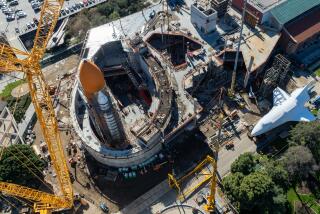Shuttle’s Orbit Lowered to Get 3-D Radar Maps
- Share via
KENNEDY SPACE CENTER, Fla. — The space shuttle Endeavour dipped closer to Earth on Friday to create astonishingly detailed 3-D radar maps of the planet that might one day enable scientists to predict earthquakes and volcanic eruptions.
By retracing its orbital steps and passing over the exact spot two days in a row, the shuttle can use its radar to map the same ground features from slightly different angles and detect changes in terrain as small as half an inch.
“Imagine if we could globally monitor earthquake faults prior to the eruption of earthquakes and see very minute changes in those earthquake faults, or if we could look at volcanoes as the domes start to expand,” said astronaut-physicist Peter (Jeff) Wisoff.
“This might lead to some type of early-warning system for population centers that are nearby those earthquake faults or volcanoes.”
Flying over the same spot on Earth is easier said than done--there are no road markers or maps in space.
NASA has never attempted to match shuttle orbits before. Earlier this week, flight directors succeeded in bringing Endeavour’s orbit to within 30 feet of where it was during a similar radar-mapping mission in April.
*
The real test came Friday. Commander Michael Baker lowered Endeavour’s altitude from 135 miles to 127 miles--one of the lowest ever for a space shuttle--to begin duplicated passes just 24 hours apart.
Early Friday afternoon, the radar surveyed a swath of North America, from western Canada to the Great Lakes to the Chesapeake Bay. Endeavour is supposed to fly the same course today so the radar can scan the same area. Repeat observations are planned over Africa, the Middle East and Siberia.
By combining these repeated images, scientists hope to produce topographic maps of incredibly high resolution--accurate in elevation to within six yards or less, compared to the current 10 yards and more. These “stereo” views will allow researchers to detect changes in the Earth’s surface as small as half an inch, said Mike Sander, project manager at NASA’s Jet Propulsion Laboratory in Pasadena.
More to Read
Sign up for Essential California
The most important California stories and recommendations in your inbox every morning.
You may occasionally receive promotional content from the Los Angeles Times.













